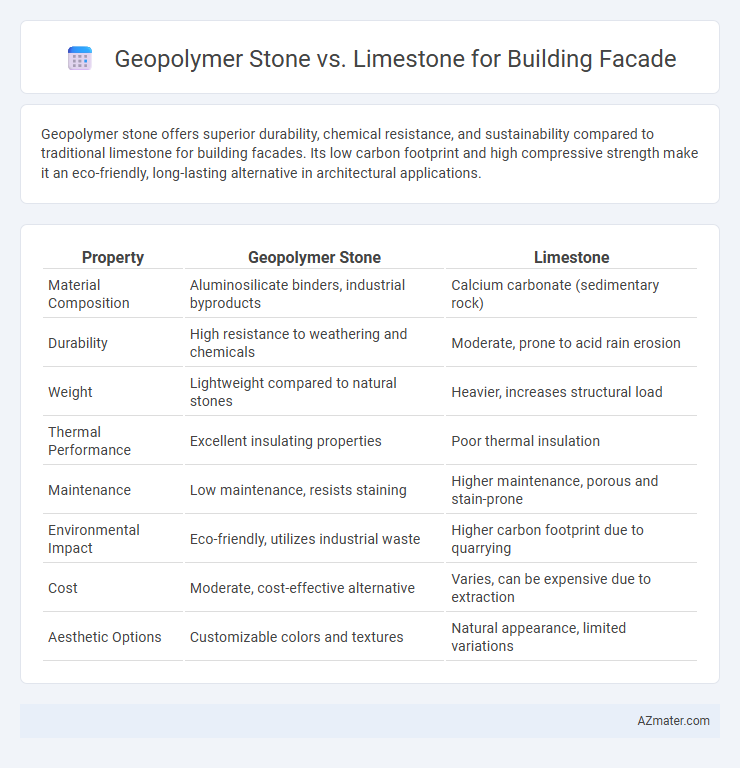Geopolymer stone offers superior durability, chemical resistance, and sustainability compared to traditional limestone for building facades. Its low carbon footprint and high compressive strength make it an eco-friendly, long-lasting alternative in architectural applications.
Table of Comparison
| Property | Geopolymer Stone | Limestone |
|---|---|---|
| Material Composition | Aluminosilicate binders, industrial byproducts | Calcium carbonate (sedimentary rock) |
| Durability | High resistance to weathering and chemicals | Moderate, prone to acid rain erosion |
| Weight | Lightweight compared to natural stones | Heavier, increases structural load |
| Thermal Performance | Excellent insulating properties | Poor thermal insulation |
| Maintenance | Low maintenance, resists staining | Higher maintenance, porous and stain-prone |
| Environmental Impact | Eco-friendly, utilizes industrial waste | Higher carbon footprint due to quarrying |
| Cost | Moderate, cost-effective alternative | Varies, can be expensive due to extraction |
| Aesthetic Options | Customizable colors and textures | Natural appearance, limited variations |
Introduction to Building Facade Materials
Geopolymer stone offers superior durability, environmental benefits, and high thermal resistance compared to traditional limestone in building facades. Limestone, a sedimentary rock composed primarily of calcium carbonate, is favored for its aesthetic appeal and natural texture but is prone to weathering and acid rain damage. Choosing geopolymer stone enhances facade longevity while reducing carbon footprint through sustainable production processes.
What is Geopolymer Stone?
Geopolymer stone is an innovative, eco-friendly building material made from industrial byproducts like fly ash and slag, activated by alkaline solutions to form a rigid, durable composite. This synthetic stone offers superior resistance to weathering, chemical corrosion, and thermal stress compared to traditional limestone, making it ideal for modern building facades. Its low carbon footprint and high compressive strength present sustainable advantages over conventional natural stone options.
Overview of Limestone as a Facade Material
Limestone is a sedimentary rock composed mainly of calcium carbonate, widely used as a building facade material due to its natural aesthetic appeal and durability. It provides excellent thermal insulation and weather resistance, making it suitable for various architectural styles and climates. Limestone also offers ease of carving and finishing, allowing for intricate design details while maintaining structural integrity over time.
Aesthetic Differences: Geopolymer Stone vs Limestone
Geopolymer stone offers a modern, customizable appearance with a wide range of colors and textures, allowing architects to achieve unique facade designs that mimic natural stone or present avant-garde styles. Limestone provides a classic, timeless look with natural variations, soft tones, and weathering patterns that evoke traditional elegance and historic charm in building facades. The aesthetic choice between geopolymer stone and limestone depends on the desired architectural expression, with geopolymer stone favoring innovation and limestone emphasizing natural authenticity.
Durability and Weather Resistance Comparison
Geopolymer stone exhibits superior durability and weather resistance compared to limestone, maintaining structural integrity under harsh environmental conditions such as heavy rain, freeze-thaw cycles, and UV exposure. The chemical composition of geopolymer stone provides enhanced resistance to acid rain and pollutants, reducing surface erosion and discoloration over time. Limestone's porous nature makes it more susceptible to water absorption and weather-induced degradation, leading to accelerated wear and maintenance needs for building facades.
Sustainability: Environmental Impact and Carbon Footprint
Geopolymer stone offers a significantly lower carbon footprint compared to traditional limestone, as its production involves less energy-intensive processes and utilizes industrial by-products like fly ash or slag, reducing landfill waste. Limestone extraction contributes to substantial environmental degradation, including habitat disruption and high CO2 emissions during quarrying and calcination. Choosing geopolymer stone for building facades supports sustainable construction by minimizing resource depletion and lowering overall greenhouse gas emissions associated with material production.
Cost Analysis: Geopolymer Stone Versus Limestone
Geopolymer stone offers a cost-effective alternative to traditional limestone for building facades, with lower raw material and production expenses due to the use of industrial by-products like fly ash and slag. Limestone extraction and processing incur higher costs related to quarrying, transportation, and environmental regulations. Maintenance costs for geopolymer stone are also lower, as it exhibits high resistance to weathering and chemical degradation compared to the porous and softer nature of limestone.
Installation and Maintenance Considerations
Geopolymer stone offers easier installation compared to limestone due to its lightweight nature, reducing labor costs and structural support requirements. Maintenance for geopolymer stone is minimal since it resists weathering, chemical exposure, and requires no sealing, unlike limestone, which demands regular cleaning and sealing to prevent erosion and staining. The durability and low upkeep of geopolymer stone make it a cost-effective alternative for building facades, particularly in harsh environmental conditions.
Thermal and Acoustic Performance
Geopolymer stone offers superior thermal insulation compared to limestone, reducing heat transfer and improving energy efficiency in building facades. Its dense microstructure also enhances acoustic performance by effectively dampening sound transmission, making it an excellent choice for noise-sensitive environments. Limestone, while aesthetically versatile, generally exhibits higher thermal conductivity and lower sound absorption, resulting in less effective thermal and acoustic insulation.
Choosing the Right Facade Material: Key Takeaways
Geopolymer stone offers enhanced durability, fire resistance, and environmental sustainability compared to traditional limestone, making it a superior choice for modern building facades. Limestone provides a classic aesthetic and natural texture but is more porous and susceptible to weathering over time. Selecting the right material depends on factors such as project budget, desired longevity, maintenance requirements, and environmental impact.

Infographic: Geopolymer stone vs Limestone for Building facade
 azmater.com
azmater.com